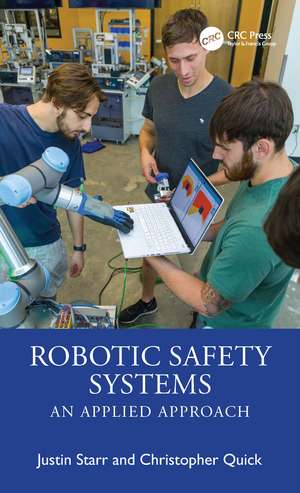Robotic Safety Systems: An Applied Approach
Autor Justin Starr, Christopher Quicken Limba Engleză Hardback – 14 noi 2024
Robotic Safety Systems: An Applied Approach discusses some of the unique concerns associated with remote I/O and systems designed to be controlled over wide-area networks, including the internet. It includes annotated example safety configurations and programs that can be customized and loaded and deployed on existing robots, giving the reader tools to immediately apply the lessons learned in this text. The text also provides best practices for using cutting-edge systems – such as cobots and mobile robotic arms (with some autonomy) – systems that have advanced faster than the regulatory frameworks. Included are real world examples from FANUC, ABB, Universal Robots, and Kuka – the most popular brands on the market. Finally, as an appendix to this text, a case study demonstrating proper use of A3/RIA standards is included. This will allow readers to make an informed decision prior to purchasing these expensive references.
This book is intended for post-secondary classes at universities with specializations in robotics or robotic engineering. It will also be useful for robot systems integrators – design engineers, consultants, integration experts, robot programmers.
Preț: 531.48 lei
Preț vechi: 577.69 lei
-8% Nou
Puncte Express: 797
Preț estimativ în valută:
101.70€ • 108.75$ • 84.79£
101.70€ • 108.75$ • 84.79£
Carte tipărită la comandă
Livrare economică 17 aprilie-01 mai
Preluare comenzi: 021 569.72.76
Specificații
ISBN-13: 9781032259895
ISBN-10: 1032259892
Pagini: 286
Ilustrații: 222
Dimensiuni: 156 x 234 mm
Greutate: 0.69 kg
Ediția:1
Editura: CRC Press
Colecția CRC Press
Locul publicării:Boca Raton, United States
ISBN-10: 1032259892
Pagini: 286
Ilustrații: 222
Dimensiuni: 156 x 234 mm
Greutate: 0.69 kg
Ediția:1
Editura: CRC Press
Colecția CRC Press
Locul publicării:Boca Raton, United States
Public țintă
Postgraduate, Professional Reference, Professional Training, Undergraduate Advanced, and Undergraduate CoreCuprins
1- Robotic Safety: Myth, Reality and Historical Perspective
2- Accidents, Case Studies and the Need for Safety Systems
3- Existing Safety Standards for Industrial Robotic Systems
4- Physical Safeguards
5- Implementations on Popular Industrial Robots
6- Collaborative Robots
7- Safety Systems, Controls and Cyber-Physical Systems
8- Networked Systems & Internet-based Control
9- Mobile Platforms: AGVs and AMRs
10- Drones, UAVs, and Aerial Safety
11- Safety vs. Progress & Advancing Technology
12- The Future of Robotic Safety Systems
Appendix A: Risk Assessment Forms
Appendix B: Case Study: Automated Solar Panel Placement
2- Accidents, Case Studies and the Need for Safety Systems
3- Existing Safety Standards for Industrial Robotic Systems
4- Physical Safeguards
5- Implementations on Popular Industrial Robots
6- Collaborative Robots
7- Safety Systems, Controls and Cyber-Physical Systems
8- Networked Systems & Internet-based Control
9- Mobile Platforms: AGVs and AMRs
10- Drones, UAVs, and Aerial Safety
11- Safety vs. Progress & Advancing Technology
12- The Future of Robotic Safety Systems
Appendix A: Risk Assessment Forms
Appendix B: Case Study: Automated Solar Panel Placement
Notă biografică
Dr. Justin Starr currently serves as the Endowed Professor of Advanced Technology at the Community College of Allegheny County where he works to integrate advanced technology into the technical curriculum including, augmented reality, electron microscopy, computer vision, machine learning, collaborative robots, and other cutting-edge topics. He is a certified FANUC and Universal Robots instructor, and has experience integrating robots in a variety of production environments. Previously, Dr. Starr served as CTO of RedZone Robotics, a manufacturer of water and wastewater inspection robots, CEO of High Tide Technologies, a developer of end-to-end cloud SCADA systems, and worked as a fractional COO for a number of private equity-backed firms in the high tech space. Dr. Starr holds 14 U.S. patents for inventions in robotics, artificial intelligence, and automation, and was named an Engineering Unleashed Fellow and Hi-TEC Fellow for his work with high-impact technologies.
Christopher Quick is the founder of RealBotics, Inc., a company specializing in remote control, telerobotics, and industrial automation consulting. His industrial automation experience includes various robotic installs in heavy forge and stamping applications, the implementation of automated guided vehicles (AGVs) on the factory floor, the use of collaborative robots in industrial settings, and various research projects utilizing machine vision. Chris also has experience with the mechanical, electrical, and computer science aspects of the design and development of mobile device platforms such as drones, cellular-based systems, and mobile robotics. Chris received his BS in Mechanical Engineering, with minors in Electrical Engineering, Computer Science, Robotics, and Computer Vision, and an MS in Engineering Management from Rose-Hulman Institute of Technology.
Christopher Quick is the founder of RealBotics, Inc., a company specializing in remote control, telerobotics, and industrial automation consulting. His industrial automation experience includes various robotic installs in heavy forge and stamping applications, the implementation of automated guided vehicles (AGVs) on the factory floor, the use of collaborative robots in industrial settings, and various research projects utilizing machine vision. Chris also has experience with the mechanical, electrical, and computer science aspects of the design and development of mobile device platforms such as drones, cellular-based systems, and mobile robotics. Chris received his BS in Mechanical Engineering, with minors in Electrical Engineering, Computer Science, Robotics, and Computer Vision, and an MS in Engineering Management from Rose-Hulman Institute of Technology.
Descriere
This text provides readers with the information needed to understand robotic safety. It includes information about standards and regulations, as well as details of how to effectively use hardware devices (such as light curtains, pressure pads, and new multi-channel lidar sensors), and software algorithms to apply motion control restrictions.
